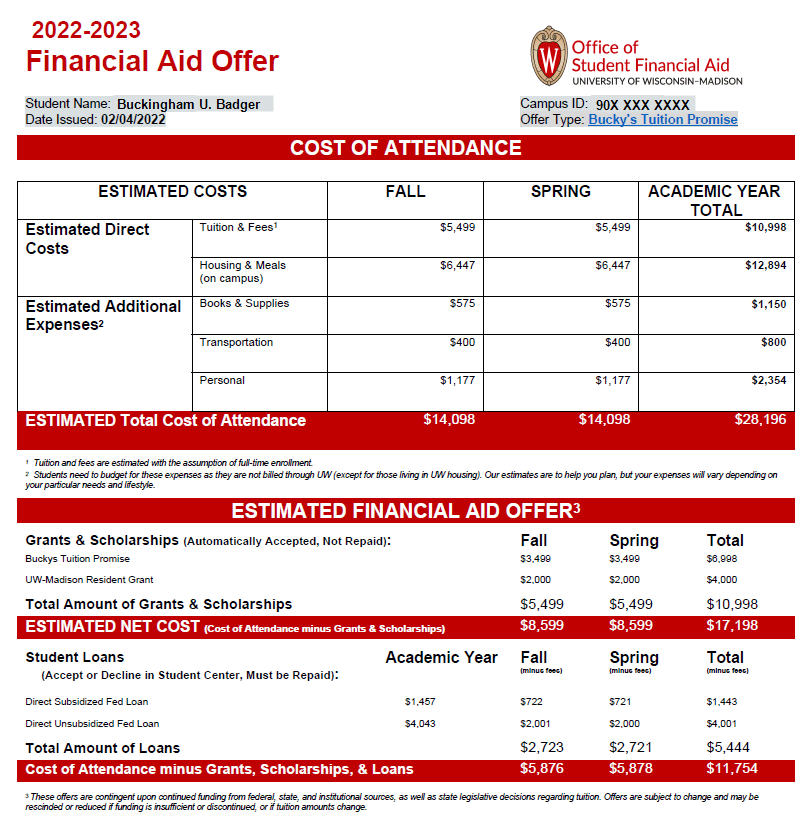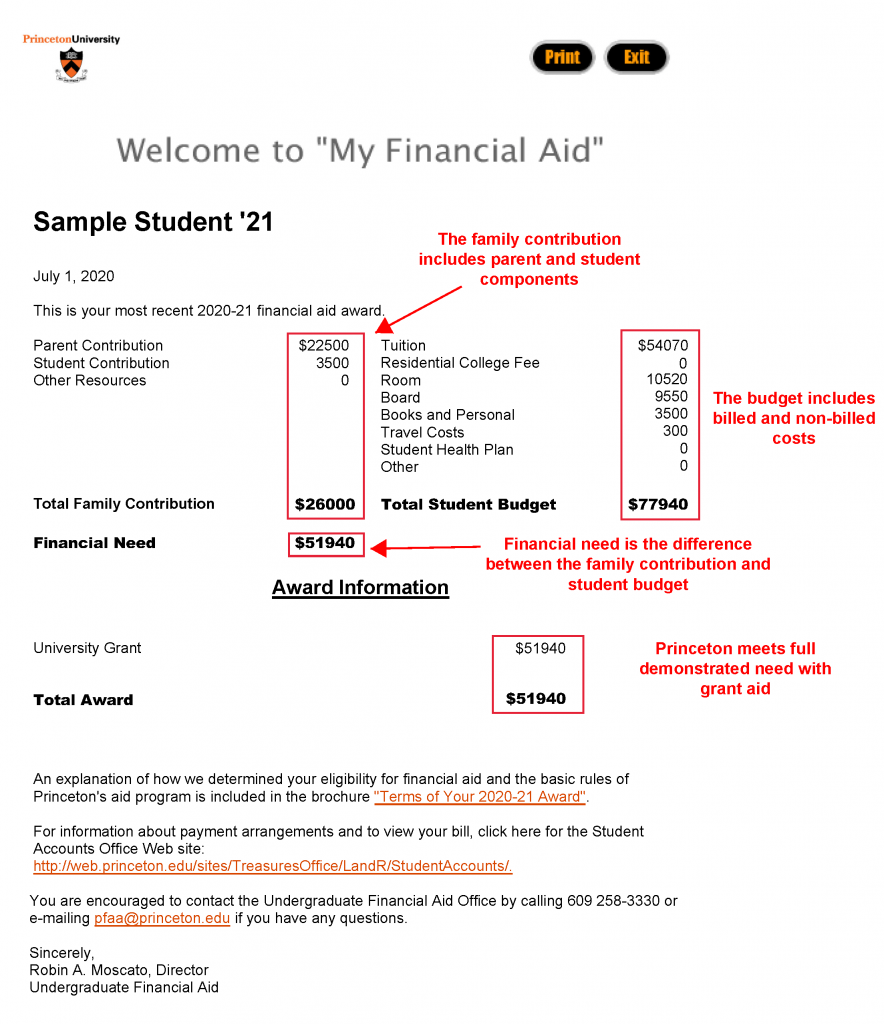If you have applied for financial aid and been accepted to a college, you will receive a financial aid award letter. This award letter is important because it allows students to compare various financial aid packages.
Unfortunately, financial aid award letters can be confusing. Some award letters may not even break down the actual cost of attendance after considering financial aid. On top of all of this, there are no standardized financial aid award letters, so every letter may be a bit different!
That’s why we are here to help you! This way you can compare your financial aid offers and pick the best option.
Jump ahead to:
Also see: Scholarships360’s free scholarship search tool
What’s in a financial aid award letter?
While the formatting and organization of financial aid award letters may vary from letter to letter, there are a few things that are common:
Aid you are awarded
All financial aid award letters will include a list of aid that you were awarded and the actual amount of aid. This is calculated based on your Student Aid Index (SAI) from your FAFSA and/or CSS Profile.
The types of aid you might see on your award letter include:
- Need-based grants including institutional grants, as well as Pell Grants and Federal SEOG Grants. These grants do not need to be repaid.
- Merit-based scholarships that you have been awarded by the institution. You do not need to repay merit scholarships.
- Student loans from the federal government which include Federal Direct Loans and Parent PLUS Loans. While student loans need to be repaid, federal student loans generally have more flexible repayment options and lower interest rates than private student loans.
- Work study which allows students to find and apply for jobs on-campus (but sometimes off-campus) to earn money to contribute towards their education.
Student loan information
The student loan section in the award letter can be particularly tricky. A report from New America analyzed award letters from 455 colleges that included unsubsidized student loans and listed the loans in 136 different ways. In fact, 24 of the award letters didn’t include the word loan at all.
Students should pay close attention to the specific types of student loans in their financial aid package. If there is anything that’s confusing or not clear, they should contact their college’s financial aid office.
This is important because unsubsidized student loans accumulate student loan interest while the student is in college while subsidized student loans do not. This makes these unsubsidized student loans less desirable for students, despite the higher amount of aid they offer in comparison to other loans.
Related: Navigating different types of student loans
Cost of attendance
In addition to the specific types of aid and amounts, the award letter will also have the cost of attendance including tuition, room, board, and other expenses.
It’s important to know that generally this is just the cost for the upcoming academic year and does not include any potential increases in tuition, room, and board. Learn about the average cost of college so you are a better informed consumer before signing off on any loans.
Related: Why didn’t I receive financial aid?
Private scholarships
Your financial aid award letter will not include private scholarships that you might win. This is why there is so much upside for students who win private scholarships. And if you were planning on taking out student loans, every dollar in scholarships that you win is money that you won’t have to pay back in loans!
However, be sure to check in with your financial advisor to make sure your outside aid doesn’t over exceed your level of need. If it does, there may be changes to the financial aid your school offers you.
@scholarships360 Even though FAFSA has been behind schedule this year, here’s a guide on how to read a financial award letter, so youll be all ready when you recieve yours! If you have multiple letters to compare, check out our free comparison tool! #scholarships360 #scholarship #FAFSA #awardletter #howto #student #education #highschool #college
How do I compare financial aid award letters?
Once you have all of your award letters available, you’ll want to compare the data to see how the various awards stack up. The best way to do this is by viewing and analyzing the data in the same place. The Illinois Student Assistance Commission has a free comparison tool that includes all of the most important data fields. You can also do this yourself in a spreadsheet.
We also offer our own financial aid award comparison tool! Be sure to check it out while you’re on our website.
The most important aspect of comparison is to compare the net price of the college or the cost after taking financial aid into account. You’ll want to put student loans in their own category because you will have to pay them back. This also allows you to understand what your total debt load will look like after four years of college.
Related: Developing a student loan repayment plan
Financial aid award letter examples
Next, we will examine a few different financial aid award letter examples to show you what an award letter might look like. Specifically, we will be reviewing letters from a private college (Whitman College), a large public university (University of Wisconsin), and an Ivy League university (Princeton University).
Jump ahead to:
Whitman College (Walla Walla, WA)
This award letter includes three different scholarships, a Federal Pell Grant, and clearly distinguishes between the Direct Subsidized and Unsubsidized student loans. You will notice that you don’t need to accept the loan portion of the financial aid package and also have the option to take out less money in student loans.
After taking into account all of the financial aid, this family is responsible for $7,349. If the student chose not to take out Federal student loans, the family contribution would increase to $12,849.
University of Wisconsin (Madison, WI)

This financial aid offer from the University of Wisconsin looks quite a bit different from the letter from Whitman College. Notably, UW breaks down the award letter per semester, but also gives the yearly totals.
A few other things to point out:
- Differences in student loan terminology and amounts compared to Whitman College.
- The University of Wisconsin also includes $2,500 in personal expenses as part of the cost of attendance. In contrast, Whitman doesn’t factor this into their letter.
- Total cost of attendance isn’t everything. UW has a cost of attendance that’s less than half of Whitman College ($32,132 vs. $63,954), but the actual cost for this student would be more: $14,056 vs. $7,349. Plus, the UW package includes more student debt.
Related: Why didn’t I receive any financial aid?
Princeton University (Princeton, NJ)

This letter from Princeton includes some annotations that are for educational purposes only. These annotations won’t be on your actual aid award letter. However, we see yet another example of a financial aid award letter.
Unlike the other award letters we do not see any mention of student loans. This is because Princeton includes only need-based grants and not merit scholarships or student loans in their financial aid packages.
Related: How to write a financial aid appeal letter (with example)
Frequently asked questions about how to read a financial aid letter
When will I receive my financial aid award letter?
Most colleges send financial aid award letters along with acceptance letters. So, typically, once you know you’ve gotten in, you’ll know how much aid they are offering that day or a day or two later. If you do not receive an award letter with your acceptance, it’s a good idea to contact the financial aid office to see if there might’ve been an error.
How do I check my financial aid award?
The answer to this question can vary by school. Most schools send out some sort of paper acceptance letter as well as a financial aid award letter. Others will have both available on their online portal. If you are having trouble locating your financial aid award letter, try reaching out to your school’s financial aid office.
Can I have too much financial aid?
Oftentimes, the federal student aid and/or your overall aid package might be reduced to compensate. In other cases, some students receive the amount leftover to spend on things like school supplies, living expenses, and more.


